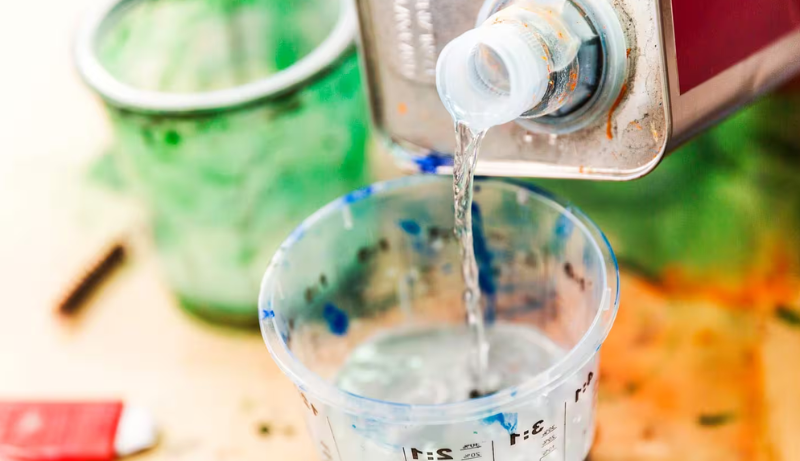Paint thinner, a solvent composed of volatile organic compounds, is a ubiquitous substance encountered by professionals in the construction and arts industries. Its versatile properties make it a staple in sectors such as automotive, construction, and the arts.
Beyond its industrial applications, paint thinner has found utility as a cleaning agent in homes and other buildings. However, the challenge lies in the safe and environmentally friendly disposal of this substance, knowledge of which remains limited.
Applications of Paint Thinner
Paint thinner, also referred to as a solvent, serves a multitude of purposes across various industries:
1. Diluting Paints and Coatings
One of the primary functions of paint thinner is to dilute paints and coatings. This process reduces the paint’s thickness, facilitating smoother application. Paint thinners achieve this by breaking down the oil in the paint, seamlessly mixing with it and reducing its viscosity.
2. Cleaning Tools and Equipment
Paint thinner proves invaluable as a cleaning agent due to its capacity to dissolve and thin out complex compounds. It excels at cleaning by effectively reducing stubborn stains that would otherwise pose a cleaning challenge. In cases where paint thinner only partially accomplishes the task, traditional soap can complement its cleaning efforts. Painters, artists, and numerous other individuals working with paint utilize thinner for cleaning purposes.
3. Thinning Epoxy Resins
While not always the ideal choice, thinners can also assist in lowering the viscosity of epoxy resin. This capability enables the resin to meet the required ratio for proper curing.
4. Surface Preparation
Paint thinner serves as an ideal solution for surface preparation before repainting. Its utility lies in its ability to effectively remove old paint, preventing it from interfering with the application of a new coat. Furthermore, it proves invaluable in eliminating dirt and other particles that might impede the seamless application of paint.
5. Removal of Paint and Graffiti
In addition to its role in paint thinning and old paint removal, paint thinner can also be employed for the eradication of unwanted graffiti. It offers a reliable method to eliminate graffiti from surfaces where its presence is undesired.
6. Artistic and Craft Applications
Within the realms of art and craft, paint thinner plays a pivotal role in enhancing artistic expression. Artists can harness the capabilities of paint thinner to achieve desired effects. Whether it involves thinning out paint for a more delicate application, lightening colors, or creating other artistic effects, paint thinner empowers painters to bring their creative visions to life with precision.
Improper Disposal of Paint Thinner
Disposing of paint thinner incorrectly can lead to significant risks, despite the apparent ease and cost savings associated with these methods. These improper disposal practices pose dangers to both individuals and the environment. Here are some methods that should never be used when disposing of paint thinner:
1. Pouring it Down the Drain
Disposing of leftover paint thinner by pouring it down the drain should be strongly discouraged. This action can result in various negative consequences, including drain damage or blockages that lead to plumbing issues. Moreover, it has the potential to harm water systems and have enduring adverse effects on both the environment and human health.
2. Burning
Burning paint thinner is a hazardous practice due to its flammable nature, which can cause fires. Furthermore, when paint thinner is burned, it releases harmful substances into the environment, contributing to air pollution. The residues left behind after burning can also pose a threat to the environment, further polluting it.

3. Dumping in the Yard
Leaving leftover paint thinner in the yard is another improper disposal method to avoid. Paint thinners contain toxic chemicals and volatile organic compounds that should not seep into the ground. When these chemicals infiltrate the soil, they can lead to soil pollution and contaminate groundwater, rendering it unsafe. Additionally, this practice can negatively impact plant life, wildlife, and even pose a danger to pets, potentially causing them harm or poisoning.
4. Evaporation
Attempting to evaporate paint thinner outdoors is an ineffective and environmentally damaging approach. It often fails to remove harmful chemicals effectively and may leave behind a concentrated residue. Moreover, this method can contribute to pollution and create a fire hazard.
5. Disposing With Household Trash
Disposing of paint thinner with household waste is an inefficient and unsafe method. The hazardous chemicals in the thinner are not neutralized in this process. Instead, they may mix with other substances, potentially spreading or leading to improper management of toxic waste.
Safe Methods for Paint Thinner Disposal
Ensuring the safe disposal of paint thinner is paramount for the well-being of both individuals and the environment. Fortunately, there are several environmentally-friendly methods available for this purpose. Here are some responsible options to consider:
1. Check and Comply with Local Regulations:
Given the hazardous and toxic nature of paint thinner, many regions have established regulations governing its proper handling and disposal. These regulations may vary from one location to another, but the overarching goal is to prevent dangerous waste disposal practices and promote safer handling and disposal procedures. Always stay informed about and adhere to the specific regulations in your area.
2. Explore Recycling Options:
Depending on your locality’s recycling programs, paint thinners can often be recycled, particularly if they are solvent-based. To recycle paint thinner, it’s essential to separate it from any paint residue or contaminants. Recycling is an excellent method for disposing of leftover paint thinners while minimizing environmental impact.
3. Select a Well-Ventilated Area:
When disposing of paint thinner, opt for an open, well-ventilated space. Outdoors with ample airflow is the preferred choice. If an indoor area must be used, ensure it has proper ventilation. Disposing of paint thinner in an enclosed space can lead to contamination, pollution, fire hazards, or even explosions.
4. Consider Hazardous Waste Collection Programs:
Many local and regional authorities organize hazardous waste collection programs to facilitate the safe collection and disposal of hazardous substances, including paint thinners. These events are tightly regulated and controlled, making them a secure option for disposing of leftover paint thinner, as well as any residues or related products. How to Dispose of Carpet?
5. Properly Handle Empty Containers:
Disposing of paint thinners entails more than just the chemical compound itself; it extends to the containers as well. It is crucial to clean and label the containers correctly to prevent their inappropriate reuse. Additionally, follow local regulations for recycling or disposing of these containers to ensure maximum safety.
Is Paint Thinner Detrimental to the Environment?
Paint thinner is comprised of a multitude of hazardous chemicals, posing a potential threat if inhaled. This underscores the importance of handling it with utmost care.
Furthermore, the substance’s toxicity justifies the necessity for a specialized disposal method. Nonetheless, even with meticulous precautions, there remains a possibility of adverse consequences. Some of these hazards encompass:
- Emission of Volatile Organic Compounds (VOCs) into the atmosphere, contributing to air pollution.
- Presence of ozone layer-depleting agents in certain types of paint thinners.
- Pouring or discarding paint thinner into aquatic environments, leading to water pollution.
- Accidental spills of paint thinner, resulting in soil contamination.
- Toxicity of paint thinners to plants and wildlife, potentially causing fatalities or harm to these organisms.
- Disruption of ecosystems upon the introduction of paint thinners into the environment.
- Greenhouse gas emissions during the production and disposal of paint thinners, contributing to climate change.
- Health risks to humans stemming from improper handling and disposal of paint thinners.

Safer Alternatives to Paint Thinner
Given the hazardous and toxic nature of paint thinner, there has been a continuous search for safer alternatives that can perform similar functions. When considering a substitute for paint thinner, it is essential to choose a substance that can effectively serve the intended purpose. Here are several viable alternatives to traditional paint thinners:
-
Water
Water is a viable alternative for thinning water-based paints, such as emulsion paints. It is a safe and eco-friendly option, making it an excellent choice for those concerned about health and environmental impact.
-
Turpentine
Turpentine is another option to consider when looking for a substitute for paint thinner. It can be used to reduce the viscosity of paint, although it should be handled with care due to its potential hazards. Nevertheless, it is a less toxic alternative compared to traditional paint thinner.
-
Mineral Spirits
For diluting oil-based paints, high-quality mineral spirits can be employed as an effective substitute for paint thinner. When using mineral spirits, it is important to work in a well-ventilated area to ensure safety.
-
Acetone
Acetone is a readily available and cost-effective option for replacing paint thinner. Its strong solvent properties make it suitable for paint removal tasks. Additionally, acetone is relatively safer and easier to dispose of, as it evaporates quickly and does not leave behind toxic residues.
-
Commercial Paint Remover
Commercial paint removers are readily available and affordable solutions designed specifically for paint removal tasks. They are formulated to safely and efficiently remove paint, making them a reliable choice.
FAQ
Why is it important to dispose of paint thinner safely and responsibly?
Proper disposal of paint thinner is essential because it is a hazardous substance that can harm human health and the environment. Incorrect disposal can lead to pollution, toxicity, and potential legal consequences.
What are the dangers of improper paint thinner disposal?
Improper disposal of paint thinner can lead to soil and water contamination, air pollution, and health risks due to toxic fumes and chemicals. It can also violate environmental regulations, resulting in penalties.
How can I determine if my paint thinner is hazardous?
Most paint thinners contain hazardous chemicals. Check the product label or Material Safety Data Sheet (MSDS) for information on its hazardous properties. If it contains toxic substances, it must be handled with care and disposed of properly.
What are the steps for safely disposing of paint thinner?
The safe disposal of paint thinner typically involves these steps:
- Store it in its original container with a secure lid.
- Keep it in a cool, dry place away from children and pets.
- Use a certified hazardous waste disposal service or a local household hazardous waste collection program.
- Never pour paint thinner down the drain or into the trash.
Can I reuse or recycle paint thinner?
Reusing paint thinner is not recommended due to its contamination potential. Recycling may be possible, but it depends on local regulations and facilities. Contact your local recycling center or hazardous waste disposal facility for guidance.
Can I dispose of paint thinner in the trash or down the drain?
No, it is unsafe and often illegal to dispose of paint thinner in the trash or down the drain. It can contaminate groundwater, harm aquatic life, and pose health risks.
Are there any alternatives to hazardous paint thinners that are easier to dispose of?
Yes, there are alternatives such as water-based paints and eco-friendly solvents that are easier and safer to dispose of. Consider using these alternatives to reduce the environmental impact.
What should I do if I accidentally spill paint thinner?
In the event of a paint thinner spill, immediately ventilate the area, wear protective gear, and contain the spill using absorbent materials like cat litter or sand. Follow local regulations for cleaning up hazardous material spills and report larger spills to the appropriate authorities.
How often should I dispose of old or unused paint thinner?
Dispose of old or unused paint thinner as soon as possible to minimize the risk of accidents or deterioration. Do not store it indefinitely, as its effectiveness may diminish over time.
Where can I find more information on proper paint thinner disposal in my area?
Contact your local government’s environmental agency, recycling center, or household hazardous waste program for specific guidelines and information on how to dispose of paint thinner safely and responsibly in your region.
In Conclusion
Improper handling and disposal of paint thinner can pose risks to both individuals and the environment. Therefore, it is crucial to exercise caution and follow proper procedures when using paint thinner, given its volatile and toxic nature.
Disposing of paint thinners incorrectly may seem convenient, but it comes with significant dangers. Fortunately, the right approach to handling and disposing of these substances is straightforward and ultimately safer for everyone involved.





Leave a Reply